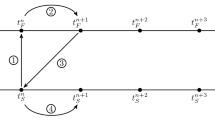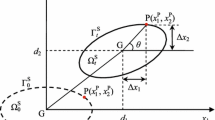Abstract
In this paper, we systematically review interface-driven mesh adaptation procedures for the phase-field modeling of fluid–structure interaction problems. One of the popular ways of handling fluid–structure interaction problems involving large solid deformations is the fully Eulerian approach. In this procedure, we use a fixed computational grid over which a diffused interface description can be used to evolve the fluid–structure boundary. The Eulerian solid representation and a diffuse interface method necessitate the use of adaptive mesh refinement to achieve reasonable accuracy for the problem at hand. We explore the usage of mesh refinement techniques for such FSI problems and focus specifically on interface-driven adaptivity. We present comparisons among various error indicators for the adaptive procedure of the unstructured mesh. We finally explore some possible future directions and challenges in the field.





Similar content being viewed by others
Notes
Examples of topology changes include contact of two bodies in a fluid, fracture of a solid body, etc.
A Newtonian fluid is a fluid where the shear stress is linearly related to the local strain rate. In other words, viscosity of a Newtonian fluid is the same at every point.
For a double-well potential function, the interface can be defined as the region where \(\phi \) varies from \(-0.9\) to 0.9 and the interface thickness at equilibrium can be estimated as \(\delta \approx 4\varepsilon \).
A primitive variable in the context of computational mechanics is a physical quantity that we numerically solve for in our system of equations, for ex velocity, pressure, etc.
A convergence criterion is a condition, which, when satisfied, marks the end of an iteration loop.
A lid-driven cavity problem is a popular benchmarking problem in CFD where we have a closed tank filled with a viscous fluid and driven by a prescribed velocity at the lid.
References
Shyy W, Berg M, Ljungqvist D (1999) Flapping and flexible wings for biological and micro air vehicles. Prog Aerosp Sci 35(5):455–505
Li Y, Scanavino M, Capello E, Dabbene F, Guglieri G, Vilardi A (2018) A novel distributed architecture for UAV indoor navigation. Transport Res Procedia 35:13–22
Joshi V, Jaiman RK, Ollivier-Gooch C (2020) A variational flexible multibody formulation for partitioned fluid–structure interaction: application to bat-inspired drones and unmanned air-vehicles. Comput Math Appl 80(12):2707–2737
Jaiman R, Guan M, Miyanawala T (2016) Partitioned iterative and dynamic subgrid-scale methods for freely vibrating square-section structures at subcritical Reynolds number. Comput Fluids 133:68–89
Joshi V, Gurugubelli P, Law Y, Jaiman R, Adaikalaraj P (2018) A 3D coupled fluid-flexible multibody solver for offshore vessel-riser system. In: International conference on offshore mechanics and arctic engineering, vol 51210. American Society of Mechanical Engineers, pp 002–08009
Griffith BE, Patankar NA (2020) Immersed methods for fluid–structure interaction. Annu Rev Fluid Mech 52(1):421–448
Trivedi D, Rahn CD, Kier WM, Walker ID (2008) Soft robotics: biological inspiration, state of the art, and future research. Appl Bionics Biomech 5(3):99–117
Kier WM, Smith KK (1985) Tongues, tentacles and trunks: the biomechanics of movement in muscular-hydrostats. Zool J Linn Soc 83(4):307–324
Belytschko T, Kennedy J (1976) A fluid–structure finite element method for the analysis of reactor safety problems. Nucl Eng Des 38(1):71–81
Radovitzky R, Ortiz M (1998) Lagrangian finite element analysis of Newtonian fluid flows. Int J Numer Methods Eng 43(4):607–619
Hirt CW, Amsden AA, Cook J (1974) An arbitrary Lagrangian-Eulerian computing method for all flow speeds. J Comput Phys 14(3):227–253
Hughes TJ, Liu WK, Zimmermann TK (1981) Lagrangian-Eulerian finite element formulation for incompressible viscous flows. Comput Methods Appl Mech Eng 29(3):329–349
Hu HH, Patankar NA, Zhu M (2001) Direct numerical simulations of fluid-solid systems using the arbitrary Lagrangian-Eulerian technique. J Comput Phys 169(2):427–462
Liu J, Marsden AL (2018) A unified continuum and variational multiscale formulation for fluids, solids, and fluid–structure interaction. Comput Methods Appl Mech Eng 337:549–597
Peskin CS (2002) The immersed boundary method. Acta Numerica 11:479–517
LeVeque RJ, Li Z (1994) The immersed interface method for elliptic equations with discontinuous coefficients and singular sources. SIAM J Numer Anal 31(4):1019–1044
Griffith BE, Patankar NA (2020) Immersed methods for fluid–structure interaction. Annu Rev Fluid Mech 52:421–448
Zhang L, Gerstenberger A, Wang X, Liu WK (2004) Immersed finite element method. Comput Methods Appl Mech Eng 193(21–22):2051–2067
Wang X, Zhang LT (2010) Interpolation functions in the immersed boundary and finite element methods. Comput Mech 45(4):321–334
Roy S, Heltai L, Costanzo F (2015) Benchmarking the immersed finite element method for fluid–structure interaction problems. Comput Math Appl 69(10):1167–1188
Griffith BE (2012) On the volume conservation of the immersed boundary method. Commun Comput Phys 12(2):401–432
Casquero H, Zhang YJ, Bona-Casas C, Dalcin L, Gomez H (2018) Non-body-fitted fluid–structure interaction: divergence-conforming b-splines, fully-implicit dynamics, and variational formulation. J Comput Phys 374:625–653
Glowinski R, Pan T-W, Hesla TI, Joseph DD, Periaux J (2001) A fictitious domain approach to the direct numerical simulation of incompressible viscous flow past moving rigid bodies: application to particulate flow. J Comput Phys 169(2):363–426
Parvizian J, Düster A, Rank E (2007) Finite cell method. Comput Mech 41(1):121–133
Burman E, Hansbo P (2012) Fictitious domain finite element methods using cut elements: II. A stabilized Nitsche method. Appl Numer Math 62(4):328–341
Belytschko T, Black T (1999) Elastic crack growth in finite elements with minimal remeshing. Int J Numer Methods Eng 45(5):601–620
Chessa J, Belytschko T (2003) An extended finite element method for two-phase fluids. J Appl Mech 70(1):10–17
Wagner GJ, Ghosal S, Liu WK (2003) Particulate flow simulations using lubrication theory solution enrichment. Int J Numer Methods Eng 56(9):1261–1289
Gerstenberger A, Wall WA (2008) An extended finite element method/Lagrange multiplier based approach for fluid–structure interaction. Comput Methods Appl Mech Eng 197(19–20):1699–1714
Dunne T (2006) An Eulerian approach to fluid–structure interaction and goal-oriented mesh adaptation. Int J Numer Methods Fluids 51(9–10):1017–1039
Wick T (2013) Fully Eulerian fluid–structure interaction for time-dependent problems. Comput Methods Appl Mech Eng 255:14–26
Richter T (2013) A fully Eulerian formulation for fluid–structure-interaction problems. J Comput Phys 233:227–240
Jain SS, Kamrin K, Mani A (2019) A conservative and non-dissipative Eulerian formulation for the simulation of soft solids in fluids. J Comput Phys 399:108922
Valkov B, Rycroft CH, Kamrin K (2015) Eulerian method for multiphase interactions of soft solid bodies in fluids. J Appl Mech 82(4):041011
Dunne T, Rannacher R (2006) Adaptive finite element approximation of fluid–structure interaction based on an Eulerian variational formulation. In: Fluid–structure interaction: modelling, simulation, optimisation. Springer, Berlin, pp 110–145
Rath B, Mao X, Jaiman RK (2023) An interface preserving and residual-based adaptivity for phase-field modeling of fully Eulerian fluid–structure interaction. J Comput Phys 488:112188
Liu C, Walkington NJ (2001) An Eulerian description of fluids containing visco-elastic particles. Arch Ration Mech Anal 159(3):229–252
Mao X, Jaiman R (2023) An interface and geometry preserving phase-field method for fully Eulerian fluid–structure interaction. J Comput Phys 476:111903
Sugiyama K, Ii S, Takeuchi S, Takagi S, Matsumoto Y (2011) A full Eulerian finite difference approach for solving fluid–structure coupling problems. J Comput Phys 230(3):596–627
Waals JD (1979) The thermodynamic theory of capillarity under the hypothesis of a continuous variation of density. J Stat Phys 20(2):200–244
Sethian JA (2001) Evolution, implementation, and application of level set and fast marching methods for advancing fronts. J Comput Phys 169(2):503–555
Fedkiw SOR, Osher S (2002) Level set methods and dynamic implicit surfaces. Surfaces 44:77
Sussman M, Smereka P, Osher S (1994) A level set approach for computing solutions to incompressible two-phase flow. J Comput Phys 114(1):146–159
Gibou F, Fedkiw R, Osher S (2018) A review of level-set methods and some recent applications. J Comput Phys 353:82–109
Zhao L, Bai X, Li T, Williams J (2014) Improved conservative level set method. Int J Numer Methods Fluids 75(8):575–590
Sussman M, Fatemi E (1999) An efficient, interface-preserving level set redistancing algorithm and its application to interfacial incompressible fluid flow. SIAM J Sci Comput 20(4):1165–1191
Peng D, Merriman B, Osher S, Zhao H, Kang M (1999) A PDE-based fast local level set method. J Comput Phys 155(2):410–438
Olsson E, Kreiss G (2005) A conservative level set method for two phase flow. J Comput Phys 210(1):225–246
Anderson DM, McFadden GB, Wheeler AA (1998) Diffuse-interface methods in fluid mechanics. Annu Rev Fluid Mech 30(1):139–165
Braun R, Murray B (1997) Adaptive phase-field computations of dendritic crystal growth. J Cryst Growth 174(1–4):41–53
Karma A, Rappel W-J (1996) Phase-field method for computationally efficient modeling of solidification with arbitrary interface kinetics. Phys Rev E 53(4):3017
Rubinstein J, Sternberg P (1992) Nonlocal reaction-diffusion equations and nucleation. IMA J Appl Math 48(3):249–264
Bretin E, Brassel M (2009) A modified phase field approximation for mean curvature flow with conservation of the volume. arXiv:0904.0098
Sun Y, Beckermann C (2007) Sharp interface tracking using the phase-field equation. J Comput Phys 220(2):626–653
Mao X, Joshi V, Jaiman R (2021) A variational interface-preserving and conservative phase-field method for the surface tension effect in two-phase flows. J Comput Phys 433:110166
Copetti MIM, Elliott CM (1992) Numerical analysis of the Cahn-Hilliard equation with a logarithmic free energy. Numerische Mathematik 63(1):39–65
Barrett JW, Blowey JF (1995) An error bound for the finite element approximation of the Cahn-Hilliard equation with logarithmic free energy. Numerische Mathematik 72(1):1–20
Kim J, Lee HG (2021) Unconditionally energy stable second-order numerical scheme for the Allen-Cahn equation with a high-order polynomial free energy. Adv Differ Equ 2021(1):1–13
Zee KG, Brummelen EH, Akkerman I, Borst R (2011) Goal-oriented error estimation and adaptivity for fluid–structure interaction using exact linearized adjoints. Comput Methods Appl Mech Eng 200(37–40):2738–2757
Cai D, Cai Z (2018) A hybrid a posteriori error estimator for conforming finite element approximations. Comput Methods Appl Mech Eng 339:320–340
Joshi V, Jaiman RK (2018) An adaptive variational procedure for the conservative and positivity preserving Allen-Cahn phase-field model. J Comput Phys 366:478–504
Bartels S, Müller R, Ortner C (2011) Robust a priori and a posteriori error analysis for the approximation of Allen-Cahn and Ginzburg-Landau equations past topological changes. SIAM J Numer Anal 49(1):110–134
Zhang Z, Tang H (2007) An adaptive phase field method for the mixture of two incompressible fluids. Comput Fluids 36(8):1307–1318
Vasconcelos D, Rossa A, Coutinho A (2014) A residual-based Allen-Cahn phase field model for the mixture of incompressible fluid flows. Int J Numer Methods Fluids 75(9):645–667
Funken S, Praetorius D, Wissgott P (2011) Efficient implementation of adaptive P1-FEM in Matlab. Comput Methods Appl Math 11(4):460–490
Wick T (2014) Flapping and contact fsi computations with the fluid–solid interface-tracking/interface-capturing technique and mesh adaptivity. Comput Mech 53:29–43
Mitchell WF (1991) Adaptive refinement for arbitrary finite-element spaces with hierarchical bases. J Comput Appl Math 36(1):65–78
Chen L, Zhang C-S (2006) Afem@ matlab: a Matlab package of adaptive finite element methods. Technique Report, Department of Mathematics, University of Maryland at College Park
Dörfler W (1996) A convergent adaptive algorithm for Poisson’s equation. SIAM J Numer Anal 33(3):1106–1124
Funding
The authors would like to acknowledge the Natural Sciences and Engineering Research Council of Canada (NSERC IRCPJ 550071-19) and Seaspan Shipyards for the funding. This research was supported in part through computational resources and services provided by Advanced Research Computing at the University of British Columbia.
Author information
Authors and Affiliations
Corresponding author
Ethics declarations
Conflict of Interest
On behalf of all the authors, the corresponding author states that there is no conflict of interest.
Additional information
Publisher's Note
Springer Nature remains neutral with regard to jurisdictional claims in published maps and institutional affiliations.
Rights and permissions
Springer Nature or its licensor (e.g. a society or other partner) holds exclusive rights to this article under a publishing agreement with the author(s) or other rightsholder(s); author self-archiving of the accepted manuscript version of this article is solely governed by the terms of such publishing agreement and applicable law.
About this article
Cite this article
Rath, B., Mao, X. & Jaiman, R. A Review of Interface-Driven Adaptivity for Phase-Field Modeling of Fluid–Structure Interaction. J Indian Inst Sci (2024). https://doi.org/10.1007/s41745-024-00422-y
Received:
Accepted:
Published:
DOI: https://doi.org/10.1007/s41745-024-00422-y




